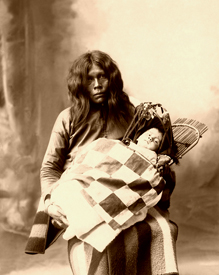The Onondaga Madonna paints a vivid
picture of the Canadian government's "colonial gaze" of the
First Nations people (Archibald-Barber, 2010).
Scott's work portrays his (along with most of the Canadian
government's) incredibly biased belief behind assimilation; this
belief generally was that the white man's way of life is better than
the "Indian's", thus the government felt it was their right
to revoke all of the First Nations people's rights and conform them
to a more British-style, colonial life.
This poem has great relevance to
English 222 because it portrays the conflicted views of Canadian
culture around the time shortly after Confederation. At the time of
the poem, the colonial view was considered the "correct"
view, and every culture that deviated from the colonial view was
considered "wrong" and needed to be "fixed".
Canadian culture was idealized as a homogenous entity that allowed no
variation away from this idealization. Thus, the government had a
problem with the culture of First Nations people.
The term "Onondaga" (link to
http://en.wikipedia.org/wiki/Onondaga)
refers to a group of First Nations people, probably a group that
Scott had knowledge of from working with them as his job to
assimilate the people. The term "Madonna" refers to the
Christian faith's representation of Jesus' mother: the Virgin Mary.
The entity that Scott describes with the title "Onondaga
Madonna" suggests the clash of the two cultures, which represent
the feelings of rest of the poem: the Canadian culture versus the
First Nations culture.
Aboriginal woman and child
The mood of the
poem is quite demoralizing with regards to the First Nations culture.
The author makes his colonial mindset about the First Nations people
quite apparent. In this poem, Scott is describing an Onondaga woman
who has refused to assimilate with the Madonna (Christian) culture.
Scott Describes
the First Nations woman as strong when Scott describes the woman's
physical appearance as "[standing]
full-throated" (line 1). This image portrays a mother (Madonna)
who is sturdy and strong, however, this notion is contradicted when
Scott adds that she is standing with "careless pose" (line
1), which begins to reveal his true negative opinions of this woman
that he is describing. Perhaps these contradictory descriptions
describe Scott's conflicted views of the people as he began to get to
know them more.
Like many of his
fellow coworkers from the department of Indian Affairs, Scott felt
their actions to the First Nations people were justified because he
thought that his actions were improving the lives of many people from
their "weird and waning race" (line 2).
Scott goes on to
describe the mother as a "tragic savage" (line 2), which
represents the predicted fate of the First Nations people as
"tragic", while maintaining the negative representation of
the people as "savages". Scott may describe the fate of
the First Nations people as tragic as a way of justifying his cause
for intervention of the people: because they will have a tragic loss
if the intervention is not successful.
Scott
goes on to describe that the woman's "rebel
lips are dabbled with the stains/Of feuds and forays and her father's
woes" (lines 7 and 8). These lines reveal Scott's opinion of
the woman as a rebel, as she is resisting the assimilation of the
colonized culture that Scott idealizes. The author refers to the
woman's ancestor's past as "woes", implying that they have
made mistake in the past, resisting the (arrogantly-considered
"superior") colonized life.
Consistent
with the poem's degrading theme towards First Nations people, Scott
refers to the mother's baby as a "primal warrior" (line
12). Once again, this shows how the colonized people's racism, and
their inability to see the First Nations people as equals, or
anything close.
Overall,
this poem is a gross blow to the First Nations people, which is
consistent with many colonial views at the time. Perhaps when Scott
describes that the child "will not rest" (line 14), he is
referring to his personal experiences working closely with the First
Nations people to attempt to force assimilation. Revealing this
personal aspect of the poem gives depth that shows the author's
passion with regards to this topic.
